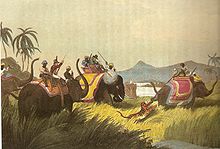
The tiger is the largest living cat species and a member of the genus Panthera native to Asia. It has a powerful, muscular body with a large head and paws, a long tail, and distinctive black, mostly vertical stripes on orange fur. It is traditionally classified into nine recent subspecies, though some recognise only two subspecies, namely mainland Asian tigers and island tigers of the Sunda Islands.

Hunting is the human practice of seeking, pursuing, capturing, or killing wildlife or feral animals. The most common reasons for humans to hunt are to exploit the animal's body for meat and useful animal products, for recreation/taxidermy, although it may also be done for non-exploitative reasons such as removing predators dangerous to humans or domestic animals, to eliminate pests and nuisance animals that damage crops/livestock/poultry or spread diseases, for trade/tourism, or for ecological conservation against overpopulation and invasive species.

Poaching is the illegal hunting or capturing of wild animals, usually associated with land use rights. Poaching was once performed by impoverished peasants for subsistence purposes and to supplement meager diets. It was set against the hunting privileges of nobility and territorial rulers.
Project Tiger is a wildlife conservation movement initiated in India to protect the endangered tiger. The project was initiated in 1973 by the Ministry of Environment, Forest and Climate Change of the Government of India. As of March 2024, there are 55 protected areas that have been designated as tiger reserves under the project. As of 2023, there were 3,682 wild tigers in India, which is almost 75% of the world's wild tiger population.

The Bengal tiger is a population of the Panthera tigris tigris subspecies and the nominate tiger subspecies. It ranks among the biggest wild cats alive today. It is considered to belong to the world's charismatic megafauna.

The Siberian tiger or Amur tiger is a population of the tiger subspecies Panthera tigris tigris native to the Russian Far East, Northeast China and possibly North Korea. It once ranged throughout the Korean Peninsula, but currently inhabits mainly the Sikhote-Alin mountain region in southwest Primorye Province in the Russian Far East. In 2005, there were 331–393 adult and subadult Siberian tigers in this region, with a breeding adult population of about 250 individuals. The population had been stable for more than a decade because of intensive conservation efforts, but partial surveys conducted after 2005 indicate that the Russian tiger population was declining. An initial census held in 2015 indicated that the Siberian tiger population had increased to 480–540 individuals in the Russian Far East, including 100 cubs. This was followed up by a more detailed census which revealed there was a total population of 562 wild Siberian tigers in Russia. As of 2014, about 35 individuals were estimated to range in the international border area between Russia and China.

The Asian black bear, also known as the Indian black bear, Asiatic black bear, moon bear and white-chested bear, is a medium-sized bear species native to Asia that is largely adapted to an arboreal lifestyle. It lives in the Himalayas, southeastern Iran, the northern parts of the Indian subcontinent, Mainland Southeast Asia, the Korean Peninsula, China, the Russian Far East, the islands of Honshū and Shikoku in Japan, and Taiwan. It is listed as vulnerable on the IUCN Red List, and is threatened by deforestation and poaching for its body parts, which are used in traditional medicine.

The Indochinese tiger is a population of the Panthera tigris tigris subspecies that is native to Southeast Asia. This population occurs in Myanmar and Thailand In 2011, the population was thought to comprise 342 individuals, including 85 in Myanmar and 20 in Vietnam, with the largest population unit surviving in Thailand, estimated at 189 to 252 individuals during the period 2009 to 2014.

Wildlife conservation refers to the practice of protecting wild species and their habitats in order to maintain healthy wildlife species or populations and to restore, protect or enhance natural ecosystems. Major threats to wildlife include habitat destruction, degradation, fragmentation, overexploitation, poaching, pollution, climate change, and the illegal wildlife trade. The IUCN estimates that 42,100 species of the ones assessed are at risk for extinction. Expanding to all existing species, a 2019 UN report on biodiversity put this estimate even higher at a million species. It is also being acknowledged that an increasing number of ecosystems on Earth containing endangered species are disappearing. To address these issues, there have been both national and international governmental efforts to preserve Earth's wildlife. Prominent conservation agreements include the 1973 Convention on International Trade in Endangered Species of Wild Fauna and Flora (CITES) and the 1992 Convention on Biological Diversity (CBD). There are also numerous nongovernmental organizations (NGO's) dedicated to conservation such as the Nature Conservancy, World Wildlife Fund, the Wild Animal Health Fund and Conservation International.

The Malayan tiger is a tiger from a specific population of the Panthera tigris tigris subspecies that is native to Peninsular Malaysia. This population inhabits the southern and central parts of the Malay Peninsula, and has been classified as critically endangered. As of April 2014, the population was estimated at 80–120 mature individuals, with a continuing downward trend.

The Wildlife Trust of India is an Indian nature conservation organisation.

Tigers in India constitute more than 70% of the global population of tigers. Tigers have been officially adopted as the National Animal of India on recommendation of the National Board for Wildlife since April 1973. In popular local languages, tigers are called baagh, puli or sher. The Bengal Tiger is the species found all across the country except Thar desert region, Ladakh, Jammu and Kashmir, Punjab and Kutch region. These can attain the largest body size among all the Felidae, and therefore are called Royal Bengal Tigers. Skin hides measuring up to 4 meters are recorded. The body length measured from its nose to the tip of the tail can reach up to 3 meters and it can weigh up to 280 kilograms, with males being heavier than females. Their average life expectancy is about 15 years. However, they are known to survive for up to 20 years in wild. They are solitary and territorial. Tigers in India usually hunt chital, sambar, barasingha, wild buffalo nilgai and gaur and other animals such as the wild pig for prey and sometimes even other predators like leopards and bears. There are instances of Elephant calves hunted by tigers.

The long-tailed goral or Amur goral is a species of ungulate of the family Bovidae found in the mountains of eastern and northern Asia, including Russia, China, and Korea. A population of this species exists in the Korean Demilitarized Zone, near the tracks of the Donghae Bukbu Line. The species is classified as endangered in South Korea, with an estimated population less than 250. It has been designated South Korean natural monument 217. In 2003, the species was reported as being present in Arunachal Pradesh, in northeast India.

The Indian leopard is a subspecies of the leopard that was first scientifically described in 1794. It is widely distributed on the Indian subcontinent. It is threatened by illegal trade of skins and body parts, and persecution due to human-leopard conflict and retaliation for livestock depredation.

Wildlife trade refers to the products that are derived from non-domesticated animals or plants usually extracted from their natural environment or raised under controlled conditions. It can involve the trade of living or dead individuals, tissues such as skins, bones or meat, or other products. Legal wildlife trade is regulated by the United Nations' Convention on International Trade in Endangered Species of Wild Fauna and Flora (CITES), which currently has 184 member countries called Parties. Illegal wildlife trade is widespread and constitutes one of the major illegal economic activities, comparable to the traffic of drugs and weapons.
The tiger is an iconic species. Tiger conservation attempts to prevent the animal from becoming extinct and preserving its natural habitat. This is one of the main objectives of the international animal conservation community. The Convention on International Trade in Endangered Species of Wild Fauna and Flora (CITES) has played a crucial role in improving international efforts for tiger conservation.

An endangered species is a species that is very likely to become extinct in the near future, either worldwide or in a particular political jurisdiction. Endangered species may be at risk due to factors such as habitat loss, poaching, invasive species, and climate change. The International Union for Conservation of Nature (IUCN) Red List lists the global conservation status of many species, and various other agencies assess the status of species within particular areas. Many nations have laws that protect conservation-reliant species which, for example, forbid hunting, restrict land development, or create protected areas. Some endangered species are the target of extensive conservation efforts such as captive breeding and habitat restoration.

The Indochinese leopard is a leopard subspecies native to mainland Southeast Asia and southern China. In Indochina, leopards are rare outside protected areas and threatened by habitat loss due to deforestation as well as poaching for the illegal wildlife trade. In 2016, the population was previously thought to comprise 973–2,503 mature individuals, with only 409–1,051 breeding adults. The historical range had decreased by more than 90%. However, as of 2019, it is estimated that there are 77-766 mature Indochinese leopards and that their numbers are decreasing.

The Siberian Tiger Introduction Project involves reestablishing populations of the Siberian tiger, also known as the Amur tiger, in their former range and also expanding their range by introducing them as replacements of their genetically similar relative, the extinct Caspian tiger, which inhabited Central and Western Asia. Currently, the Siberian tiger inhabits the cold mountains of the Russian Far East and northern China.

Many species are affected by poaching, including illegal hunting, fishing and capturing of wild animals, and, in a recent usage, the illegal harvesting of wild plant species. The article provides an overview of species currently endangered or impaired by poaching in the Americas, sub-Saharan Africa, and South-East Asia.



























